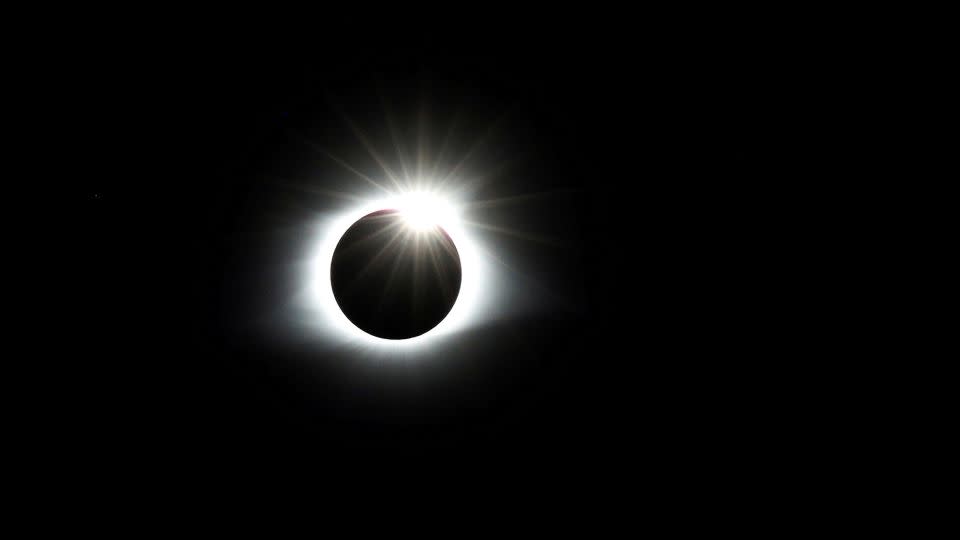[ad_1]
If you plan to see the epic total Solar eclipse That will dance across the North American skies on Monday, you should aim to travel near… The center of the path of the celestial scene as possible.
The new mapping calculations have raised some concerns that the total path — where the Moon can be seen completely blocking the Sun — is slightly narrower than NASA calculates. This means that some towns on the edge of the road that were expecting to see a second or two of total darkness may be left out.
NASA has not changed its forecasts, but the space agency advises that there is some uncertainty regarding mapping the eclipse's path.
“Calculations using a slightly larger radius for the size of the Sun yield a slightly narrower eclipse path,” NASA spokeswoman Karen Fox said in an email statement. “This difference will only affect cities at the edge of the totality path, where comprehensive predictions are difficult regardless – a few buildings in a city one way or another could mean 20, 10, or 0 seconds of totality.”
For viewing purposes, NASA scientists and other experts recommend that spectators head to the middle of the track, not its perimeter anyway.
“I will never be near the edge of this totality because it is the difference between night and day,” said Dr. Edward Guinan, a professor of astronomy and astrophysics at Villanova University.
Mapping the moment
Recent questions about the possible changed route have focused on a new map calculated by John Irwin, a software developer based in Guildford, England, and posted on a web page called Becilian elements.
Guinan said the research has not been thoroughly reviewed by scientists. Even if the NASA map is wrong, Irwin calculates that it is only a few thousand feet from the edges.


Irwin did not immediately respond to an email request for comment Friday.
But few things in science are ever certain. NASA also acknowledges the difficulty of determining precise measurements of the eclipse's path.
“Accurate eclipse prediction has drawn new attention to a small but real uncertainty about the size of the Sun,” NASA said in a statement. “Uncertainties in the Earth's rotation could also affect eclipse predictions at this level.”
Guinan explained that it is very difficult to determine an accurate measurement of the size of the Sun because it is a “murky surface.”
He pointed out that the Sun could be slightly inflated at the present time because our star is currently going through a period of maximum magnetic activity, which “may cause the Sun to inflate slightly.”
But the uncertainty is only a few hundred feet, while the Sun is nearly a million miles across.
However, even slight adjustments in the sun's size can gently shift the edges of the moon's shadow on Monday.
Edge effects
The Besselian Elements website advertises that people should consult Irwin's alternate eclipse map if they hope to travel to the edge of the path – where the length of total darkness may be very short but spectators can get an extended look at the many other eclipse-related elements visible.
Guinan points out that eclipses offer “edge effects.”
“You won't see the total eclipse, but you will see the diamond ring effect — flashes of the sun going in and out behind the mountains and passing through the valleys on the moon,” he said. “This would be great if you've seen a lot of the eclipse.”


“But I don’t advise people to do that,” he added.
NASA also said in its statement: “Travelling toward the center of the kidney's path — even a mile or two — will quickly increase the length of the kidney that people can see.”
And it is complete Real showGuinan confirmed.
This phase of the eclipse will plunge the region into darkness. The temperature will drop. The animals will act as if it is nighttime. The Sun's corona – or its extremely hot outer atmosphere – will be visible. Bright stars and planets will shine in the surrounding sky.
“When you see a total eclipse, you can't go back,” Guinan said. “she's amazing.”
Don't miss upcoming eclipse and space stories! Follow the topic of astronomy See the latest stories in your personalized feed with your free account.
For more CNN news and newsletters, create an account at CNN.com
[ad_2]
Source

